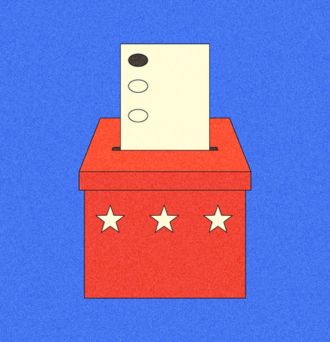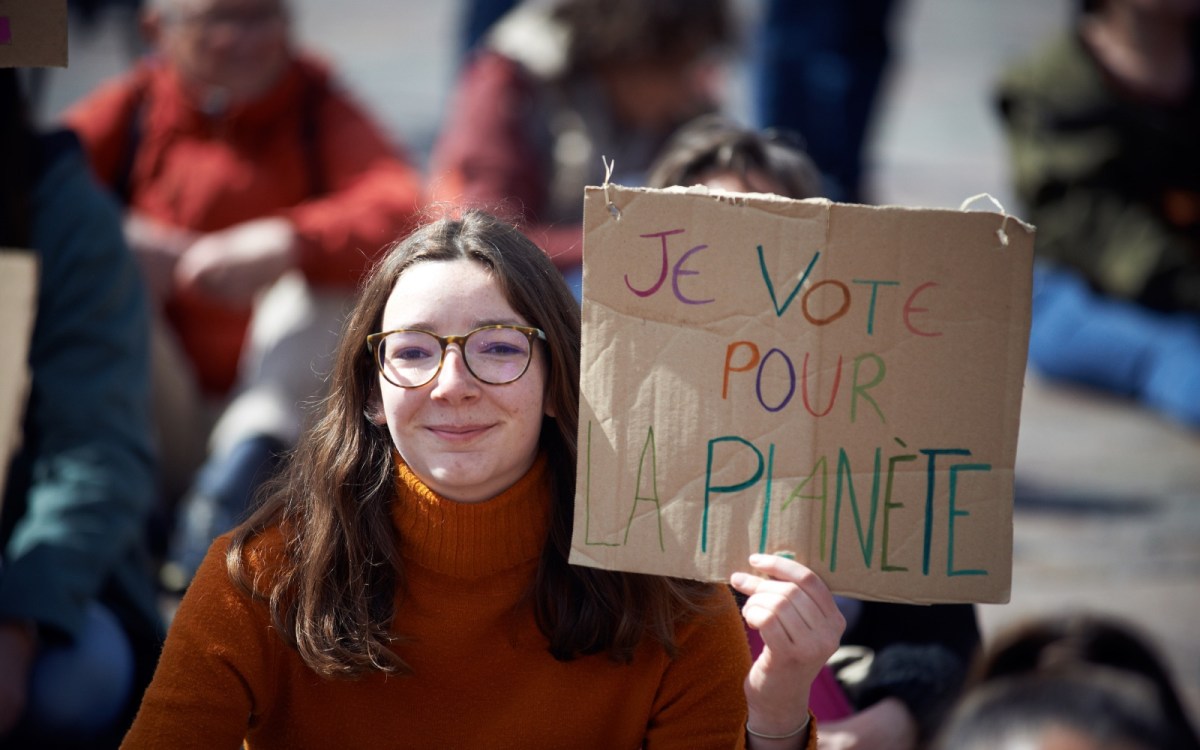
By: Claire Elise Thompson, Associate Editor
We’ve arrived at the fifth and final piece in our series on personal action! Over the past month, we’ve explored how individuals are pushing toward a clean, green, just future in their personal lives, in the courts, at work, and within their communities. Today’s story focuses on a vehicle for systemic change that at first glance may not seem like a space for personal action: policy.
Most Americans agree that the U.S. should be enacting more ambitious climate policies, but influencing that as an individual may feel out of reach. In this piece, experts explain why they see elections as the most important space for individuals to get involved — and how focusing on this type of action can even help us leave behind guilt over personal carbon footprints.
The vision
“We want to be in the business of creating more environmental voters. Because if we do that, politicians will follow. They will follow, or they won’t get to be politicians anymore, simply because every politician needs to win an election.”
Nathaniel Stinnett, executive director of the Environmental Voter Project
The spotlight
When Molly Kawahata worked as a climate adviser to the Obama White House, she remembers interns being horrified that they had no recycling bins in their office. How could the team be working toward sustainability in their jobs but ignoring something as basic as recycling? In fact, she says, the building has a trash-sorting system on the back end that offers greater efficiency — something she routinely explained to the shocked interns. But it got her thinking: “Even if we were throwing recyclables into the garbage, the impact we would be having on policy that we were pushing would be so much more significant,” she says. “I mean, it blows that out of the water.”
This idea that there could be some sort of hypocrisy in caring about or fighting for the climate while leading a less-than-perfectly-sustainable life rankled Kawahata. “You’re taking a system based in fossil fuels and apportioning blame onto the end user who’s forced to use it,” she says, an effort that seeks to discredit the voices of people attempting to change that system.
Today, Kawahata focuses on psychology as a tool to push the climate movement toward hope and systemic change, and travels as a speaker and consultant. She says that the number one question she hears from the people she talks to is what they can do to help combat climate change. “They usually think I’m going to tell them to go vegan,” she says. “They don’t expect me to say elections are the answer.”
But, in her view, policy change is the path to large-scale systemic change — and voting is how people exercise their influence over policy. Although many people don’t immediately see these as environmental actions, building the electorate and getting more voters to the polls is where she believes individuals can truly have an impact for the climate. Whether the people doing that are also vegans who recycle, she’s not overly concerned.
“It starts with just winning elections,” Kawahata says. “A short-term, individual action everyone can take is [help] win elections for pro-climate candidates and get more environmentalists to vote.”
. . .
“I wish every climate activist understood one thing,” says Nathaniel Stinnett, founder and executive director of the Environmental Voter Project (who was featured on our 2016 Grist 50 list). “Whether you vote or not is public record. So campaigns look up who votes, and then focus only on those voters” — and their stated priorities.
Simply by voting regularly, Stinnett says, you increase the visibility of the issues you care about, and the likelihood that politicians will act on them. On the flipside, not voting basically guarantees your priorities will be ignored.
Stinnett worked for over a decade as a political campaign adviser in the early 2000s. He and the teams he worked with paid close attention to voter polling, and he was consistently frustrated to see that very few voters listed climate change or other environmental issues as a top priority.
In 2014, after managing an unsuccessful mayoral campaign in Boston, Stinnett was taking a break from politics as he and his wife were expecting their first child. “I was just having lunch with a friend of mine who’s a pollster, and we were looking over some data together and something caught my eye,” he recalls. It was a rare poll that broke out both voters’ and nonvoters’ priorities. Stinnett saw that among the nonvoters, climate change and environmental issues seemed more likely to rank highly.
“That just hit me like a ton of bricks,” he says. “Maybe the climate movement doesn’t have a persuasion problem as much as we have a turnout problem.”
Stinnett founded his own nonprofit to put a laser focus on that problem. The Environmental Voter Project, or EVP, is now active in 19 states and has participated in over 100 elections just this year. “It is always election day for the Environmental Voter Project somewhere,” he says cheerily.
Stinnett and his team use a combination of data science and behavioral science to identify nonvoting environmentalists and get them to become more consistent voters. He describes the approach as “really, really nerdy.” When he first started the nonprofit, he knew the concept was solid — but “never in my wildest dreams did I think volunteers would be excited by this,” he says.
Emily Church, one of the organization’s more than 6,000 volunteers, embraces the nerdiness. She began phone banking with EVP during the 2018 midterm season.
“We need to pass meaningful legislation, and we need voters who care about climate change to vote [in order] to get there,” she says. “And it turns out we know how to do that, so let’s just do that.”
Since last year, Church has been leading a canvassing campaign in Pittsburgh, where she just finished her first year as a professor of biology at Chatham University. She says canvassing with EVP helped her not only feel like she was making a difference for the climate movement, but also feel more connected to a new city.
Stinnett cites one more reason that focusing on voters appeals to volunteers: unlike many other types of climate action, in elections the battles are contained and the outcomes tangible.
Last month, EVP had hundreds of volunteers engaged in mobilizing environmentalists to vote in the Denver mayoral election. “That is so much smaller than trying to save humanity,” Stinnett says. And although the organization doesn’t endorse candidates, Stinnett and his team make sure that volunteers can clearly see their wins in other ways, often through data.
“Even if the election doesn’t turn out the way that you might have wanted it to, if we get 300 people to vote for the very first time, they’re gonna show up again and again and again and start driving policymaking,” he says. “Those are wins. Those are examples of systemic change.”
. . .
In the 2022 midterm elections, clean energy proved to be a winning issue in some key races, and around half of voters cited climate change as an important issue in their decisions, according to one poll.
Kawahata, who recently joined the board of the Environmental Voter Project, attributes policy wins like the Inflation Reduction Act to this growth of the climate electorate. “That all goes back to community organizers on the ground in Georgia, largely being organized by Stacey Abrams and her organizations,” Kawahata says. “[They] registered people to vote at historic rates and also did what they could to fight voter suppression — and in that process, flipped a state that everybody said had no chance of ever flipping, which became the margin of victory for us to get something like the IRA passed.”
To be clear, Kawahata commends people making green lifestyle choices if that’s in the cards, she says. But what she opposes is making people feel guilty or ashamed for not doing everything in their power to work around the prevailing system. “If I turn off my lights at night and I live in a sad, dark house, am I a climate hero?” she jokes.
When people feel bad or anxious for simply living a normal, modern life, she fears not only the paralyzing effects for climate action, but also the impacts on psychological well-being.
“On some level, it’s just a shitty thing to do to people,” says Kawahata. It isolates people, and effectively gatekeeps the environmental movement.
By contrast, taking action as part of a community has shown to be an antidote to climate anxiety for some. “There’s so much empowerment in the solidarity of being part of a movement and part of a team that’s all focused on addressing the same thing. It’s the perfect tonic for a very scary moment in time,” Stinnett says. And the movement for voter mobilization doesn’t just happen every four years — it’s year-round work, he says, offering many chances to take meaningful action from the local to the national level. “Every election can be a lever for change.”
— Claire Elise Thompson
More exposure
Read: a catalog of climate actions that can be joyful — including voting and mobilizing other voters (Grist)
Read: about the Environmental Voter Project’s efforts to expand into more red states (NBC News)
Read: how Gen Z voters have fueled a new appetite for climate as a campaign issue (Washington Post)
Read: about how climate impacts are making it more difficult to cast a ballot in some places (Prism)
Watch: The Scale of Hope, an hour-long documentary about Kawahata’s climate work, her journey with mental health struggles, and her ice-climbing endeavors (Patagonia Films)
See for yourself
Do you make a habit of voting in every election in your area? Have you even gone beyond that, to support friends and neighbors in doing the same? And do you feel that being a voter forms a part of your identity?
Reply to this email to tell us about your relationship with voting. (And if it’s helpful, vote.org is a good one-stop shop to check if you are registered at your current address, remedy that if you are not, and find other resources like election reminders and information on requesting an absentee ballot.)
A parting shot
The U.S. isn’t the only country where climate action is becoming an increasingly important issue in elections. Before the first round of the French presidential election last year, thousands took part in a “March for the Future” in cities all over France to call for candidates to heed the warnings of the most recent IPCC report. In this photo, a young protester in Toulouse holds a sign reading, “I vote for the planet.”

